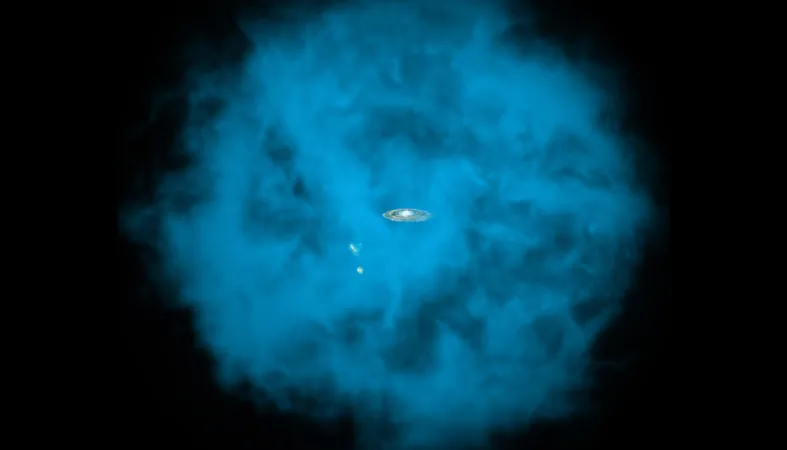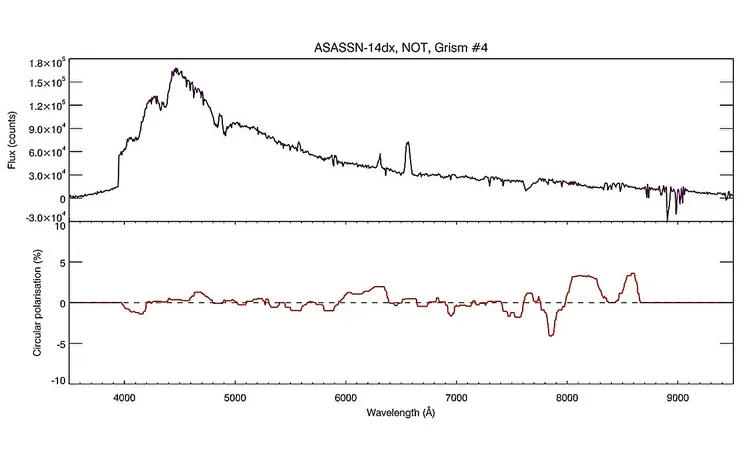
Astronomers Discover Half of the Universe's Missing Hydrogen Gas!
2025-04-14
Author: Sarah
A Shocking Discovery in Cosmic Composition
In a groundbreaking revelation, astronomers have unearthed a stunning truth about the universe: over half of the normal matter, specifically the essential hydrogen gas, has been hiding in plain sight. For years, scientists have struggled to account for all matter produced during the Big Bang, a staggering 13.6 billion years ago. Surprisingly, over 50% of the ordinary matter—part of the 15% that isn't dark matter—appeared to be missing from our cosmic calculations.
The Hidden Halo of Hydrogen
But recent analyses have shed light on this cosmic conundrum, revealing that the elusive matter exists in the form of a vast, diffuse halo of ionized hydrogen gas surrounding galaxies. This gas is more extensive and spread out than previously imagined, offering a glimpse into the universe's hidden structures.
What This Means for Galactic Evolution
This discovery not only reconciles conflicting astronomical data but also implies that supermassive black holes at the centers of galaxies are more active than once believed. It turns out these powerful entities could be releasing gas much farther from their cores—up to five times farther—than expected.
Boryana Hadzhiyska, a lead researcher from UC Berkeley, stated, "We believe that as we probe further from galaxies, we may uncover all of the missing gas. A more careful analysis with simulations will help us verify this claim—it's essential work that we’re eager to dive into."
The Warm-Hot Intergalactic Medium
Our universe is composed of around 84% dark matter, but the remaining 16% of normal matter is crucial for understanding cosmic formation. Shockingly, only about 7% of this normal matter exists in visible stars; the rest is an invisible network of ionized hydrogen gas and electrons strung across the cosmos, dubbed the warm-hot intergalactic medium.
Stacking Galaxies to See the Gas!
How did scientists measure this elusive gas? The research team stacked images of approximately 7 million galaxies up to 8 billion light-years away and analyzed the cosmic microwave background—an ancient relic of the Big Bang. By measuring subtle changes in the background radiation caused by scattered electrons in the ionized gas, they realized they could trace the gas’s distribution.
Ferraro explained, "The cosmic microwave background serves as the ultimate backdrop to our universe. It allows us to effectively illuminate where the gas exists."
The Power of Collaboration
This monumental study, backed by 75 scientists worldwide, has already stirred excitement within the scientific community. The findings, shared in various forums and currently undergoing peer review, are set to challenge our understanding of cosmic evolution.
Rethinking Black Holes and Star Formation
Traditionally, astronomers believed that black holes at galaxy centers expelled gas only during their formative years, creating what are known as active galactic nuclei (AGN). However, this new perspective suggests that black holes may also emit gas later in their lifetimes, leading to more extensive and dynamic galactic feedback mechanisms that play a significant role in star formation.
The Future of Cosmic Research
Hadzhiyska emphasized the importance of understanding the distribution of gas to tackle various cosmic mysteries. The continued exploration of how gas behaves in relation to dark matter will prove vital for resolving long-standing inconsistencies in cosmological models.
As this research opens new avenues and questions about galaxy formation and evolution, the astronomical community is buzzing with anticipation. Will unlocking the secrets of this hidden hydrogen help us better understand the vast, complex cosmos we inhabit? Time will tell!





 Brasil (PT)
Brasil (PT)
 Canada (EN)
Canada (EN)
 Chile (ES)
Chile (ES)
 Česko (CS)
Česko (CS)
 대한민국 (KO)
대한민국 (KO)
 España (ES)
España (ES)
 France (FR)
France (FR)
 Hong Kong (EN)
Hong Kong (EN)
 Italia (IT)
Italia (IT)
 日本 (JA)
日本 (JA)
 Magyarország (HU)
Magyarország (HU)
 Norge (NO)
Norge (NO)
 Polska (PL)
Polska (PL)
 Schweiz (DE)
Schweiz (DE)
 Singapore (EN)
Singapore (EN)
 Sverige (SV)
Sverige (SV)
 Suomi (FI)
Suomi (FI)
 Türkiye (TR)
Türkiye (TR)
 الإمارات العربية المتحدة (AR)
الإمارات العربية المتحدة (AR)